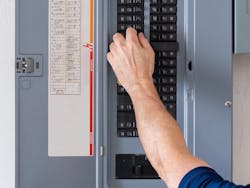PG&E’s ‘personal microgrid’ device aims for home resiliency in fire-prone areas
The use of fossil-fuel generators and home microgrids has increased in Pacific Gas & Electric’s (PG&E) territory in response to fires and public safety power shutoffs (PSPS), and now the California utility has unveiled a device that makes it easier for homeowners to disconnect personal microgrids from the grid during outages and reconnect them automatically when utility power is available.
Demand for home microgrids, especially in California, began to surge in 2020, and one company said that demand had jumped 1,000% in October 2020.
PG&E’s “personal microgrid backup power transfer meter device” helps meet this demand for resiliency, allowing qualifying homeowners with batteries or generators to avoid the utility interconnection process — which can be lengthy.
The utility’s device is available to customers who have already purchased generators under a PG&E rebate program, said Paul Doherty, PG&E spokesman. In addition to allowing users to avoid the interconnection process, the device makes it easier to connect to and disconnect from the grid without users needing to install a transfer switch.
“There’s a whole interconnection process for third party resources, solar and batteries, anything that brings additional load onto the grid, but with this new technology, you don’t have to go through the interconnection process,” said Doherty.
Connecting personal microgrids
Developed from scratch by PG&E’s metering services and engineering team, the device is connected to the home’s meter socket and comes with a 20-foot cable.
It allows qualifying customers to connect PG&E-approved generators or batteries to PG&E’s system to create a personal microgrid that can island from the grid. The device is free for customers who purchase generators or batteries through the company’s generator and battery rebate program, with priority given to customers in high-fire-threat regions and those with medical conditions. Qualifying customers also must have a smart meter, said Doherty.
All the qualifying generators meet state air quality requirements, Doherty added.
PG&E’s device for personal microgrids is the first such technology approved for use by California utilities, he said. It helps ensure personal microgrids are safe — these kinds of devices can create heat, he noted.
To connect the portable generator to a smart meter, customers turn off all breaker switches in their home’s fuse box, turn off any solar panels, plug the device’s cord into the bottom of the smart meter and into the generator. They then start the generator and turn on the switches they’d like powered during an outage. The switches might provide power to critical appliances such as refrigerators. PG&E customers can leave the device connected until an outage, or connect it once an outage has occurred, said Doherty.
Without such a device, people run cords from outside generators through a window, door or garage to the refrigerator or other appliances, said Doherty.
Californians’ efforts to gain resilience through backup generators have been hard on the environment.
The new device comes as use of the alternative to microgrids — backup generators — rises. In the San Francisco Bay Area, use of backup generators increased by 34% over the last three years in response to PSPS and outages, according to research from the consulting group M. Cubed. The backup generators equate to 15% of the state’s total electric capacity and 90% of them use carbon-intensive diesel fuel.
Kurt Johnson, community energy resilience director for The Climate Center, which aims to reduce climate pollution, said, “It is commendable that attention is being focused on how to make home generators safer. And it is appalling that California’s power reliability has become so bad that there has been a massive increase in residential generators, which pose a public safety, air pollution, noise pollution and climate threat.”
Another alternative
“By deploying vehicle-to-grid technology, the latent capacity of mobile batteries could be marshaled when needed to serve as power grid resilience assets, both for individual homes as well as the larger grid,” said Johnson.
California’s existing electric vehicle fleet has a capacity of roughly 40 GW and it is rapidly growing. By comparison, California’s evening load ramp is roughly 12-15 GW, said Johnson.
Utilities are beginning to look into vehicle-to-grid programs.
A 2018 pilot by PG&E found that vehicle-to-home technology is capable of islanding and supporting household loads during outages and demand response events from a technological point of view. Customers also expressed high interest.
Learn about the latest microgrid technologies. Join us for Microgrid 2022: Microgrids as Climate Heroes, June 1-2 in Philadelphia, Pennsylvania.
PG&E has submitted proposals to the California Public Utilities Commission for additional EV projects, including residential and commercial vehicle-to-grid projects as well as vehicle-to-microgrid projects. Regulators have not yet ruled on the proposals.
Meanwhile, PG&E has developed a multifaceted microgrid strategy for coping with outages due to fire and power shutoffs.
As for the personal microgrid device, PG&E is proud that its research team developed the device from scratch. The utility has applied for a patent and plans to offer the device to utilities in regions that experience outages, said Doherty.
In its own territory, PG&E expects to install up to 10,000 of its transfer devices this year, based on the number of customers who are participating in the generator rebate program.
“We have identified thousands of customers who would be eligible,” said Doherty. “We’re really excited about this.”
Track news about personal microgrids. Subscribe to the free Microgrid Knowledge Newsletter.








